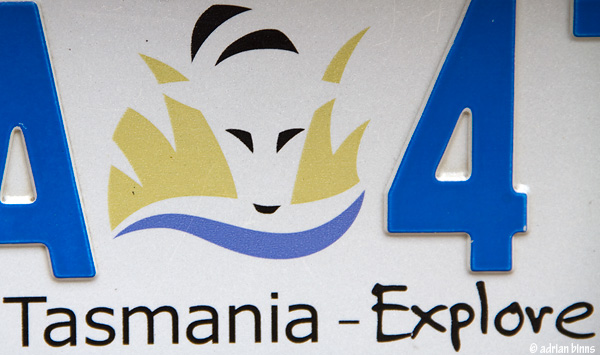AUSTRALIA: TASMANIA: Mt. Field NP to Bruny Island
Nov 16, 2012 | by Adrian Binns
Oct 8: The final leg of our Australian tour began with an early rise for a long day of travel. We departed Perth at 5:45am, reaching Melbourne 3 1/2 hours later, local time 12-noon, with the time change. Following a four-hour layover, the one-hour flight to Hobart went quickly. We arrived in Tasmania in the late afternoon, and after sorting some confusion with the van rental, we were on our way for the 15 km drive into Hobart and our hotel.
After arriving at the hotel, there was just enough light for our group of eager birders to spot a Silvereye, the beautiful Tasmanian subspecies, along with three introduced species, Eurasian Blackbirds, Eurasian Goldfinch and Greenfinch, all foraging amongst the trees surrounding the hotel courtyard. We checked into our rooms and walked a few doors down the road to enjoy an excellent dinner at the Indian Cuisine.
Oct 9: “Blackbird singing in the dead of night.” McCartney’s infamous lyrics echoed in my head as I awoke to a crisp morning in “Tassie,” the birds already up and singing. Tasmania, the only island state in the vast country of Australia, is home to 12 endemic avian species found nowhere else in the world, and our goal was to see them all during our 3-day visit. On the hotel grounds, we quickly saw the same species found upon our arrival last night – Silvereye, Eurasian Blackbird, Eurasian Goldfinch and Greenfinch – and added a new one, Little Wattlebird.
We spent most of the morning in Mt. Field National Park, about an hour north of Hobart. On the journey there, we drove along the Derwent River, and easily found our first endemic target, a flock of Tasmanian Nativehens in a field. These flightless, olive-grey gallinules were quite common throughout our stay. Also nearby were Masked Lapwings, Striated Pardalotes, and Superb Fairywrens. Ascending towards the Park, we passed Hops farms and Blue Gum plantations.
As often happens, the Visitors Center at Russell Falls was the site of much activity. We watched two Tasmanian Pademelons (marsupials) foraging in the car park. We tried unsuccessfully to track down a Crescent Honeyeater that Barry heard, but found our second endemic, the Tasmanian Thornbill, mixed in with a flock of Brown Thornbills. Shortly thereafter we added two more: Black-headed Honeyeater and Yellow Wattlebird, with its long-hanging, yellow-orange wattles. This wattlebird is the largest species of the extensive honeyeater family. A party of Superb Fairywrens pecked around the ground.
Our walk to Russell Falls, Tasmania’s best known scenic attraction, was lined with Kangaroo Ferns along the water’s edge, along with giant eucalypts and myrtles towering overhead. We paused to watch a beautiful Pink Robin perched low along the trail. The falls were impressive, featuring three elegant tiers framed by lush vegetation. On the return, we came across another endemic, the Black Currawong, close enough to see its golden eye and thick bill.
After enjoying our picnic lunch on tables outside the visitors center, we drove a short distance to Tall Trees, another section of the Park. Here we walked through a wet temperate sclerophyll rainforest, dominated by the world’s tallest flowering plants, Swamp Gums, a eucalyptus.
Some afternoon rain did not deter us from our birding endeavor. We couldn’t complain, as it was the first daytime rain we encountered throughout our whole long trip of Australia. We caught the afternoon ferry from the “Little Island” (Tasmania) to the “Small Island” (Bruny). The “Big Island” is Australia! It was a short, 15-minute ride, with Kelp Gulls waiting dockside to see us off (or see if we dropped anything for them to scavenge!).
Bruny Island is actually comprised of two land masses – North and South – separated by a narrow isthmus known as “The Neck”. The lush, green landscape reflects cooler temperatures, regular rainfall, and a population of just 650 people on 360 square km. Compared to Singapore, which is a third smaller in size, with a population of 5 million, we realized this is truly a special place. Driving country roads, we passed large open pastures and light brush land, and never encountered another soul. True wilderness.
Bruny Island is classified as an international Important Bird Area (IBA), being home to the 12 endemics, supporting endangered species, as well as nearly a quarter-million breeding pairs of Short-tailed Shearwaters (aka Tasmanian Muttonbirds). Little Penguins also breed here though we would not see these during daylight hours. We stopped at “The Neck” on our way to our Explorers Cottages on South Island, and saw Pied Oystercatcher and a flock of Yellow-tailed Cockatoos.
Our fifth Tassie endemic would be a Green Rosella, feeding besides the Bruny Hotel (the place we ate, not slept!). Still raining, we ventured out of the van to scan the sand beach and rocks jutting into the bay on the far side of the road. I stood next to the scope, covering it with an umbrella so we could all see Black-faced Cormorants, Pied and Sooty Oystercatchers. A pair of Hooded Plovers flew in unexpectedly and landed on the beach, much to Barry’s delight.
The Bruny Hotel served up an excellent dinner, after which we retired for the night. A Common Brush-tailed Possum walked along the road ahead of us as we turned into the Explorers Cottages – a fitting end to a long day of exploring the Little and Small islands of Australia!
all photos © adrian binns

































